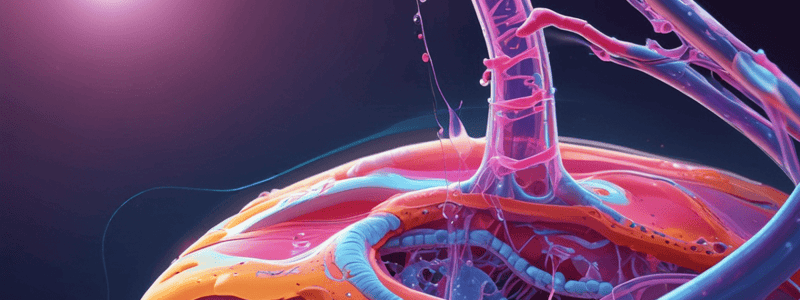Podcast
Questions and Answers
Match the following terms with their descriptions:
Match the following terms with their descriptions:
Osmosis = Movement of water towards an area with higher solute concentration Assisted Membrane Transport = Carrier-mediated transport with key molecules being proteins Facilitated Diffusion = Substances move from a higher to a lower concentration through proteins with affinity to specific molecules Glucose Transport = Means by which glucose is transported into cells
Match the following terms with their functions:
Match the following terms with their functions:
Carrier-Mediated Transport = Transport of molecules facilitated by carrier proteins Conformational Change = Change in shape of carrier protein upon binding of molecules Binding Sites = Locations inside carrier proteins where molecules bind Refractory Periods = Time periods where membrane cannot respond to another stimulus
Match the following processes with their outcomes:
Match the following processes with their outcomes:
Permeability Changes = Alterations in membrane permeability due to various stimuli Homeostasis = Maintenance of stable internal environment despite external changes Water Movement = Directional flow of water based on solute concentration gradients Action Potential Propagation = Transmission of electrical signals along nerve cells
Match the following terms with their definitions:
Match the following terms with their definitions:
Match the following actions with their effects on cell membrane permeability:
Match the following actions with their effects on cell membrane permeability:
Match the following terms with their respective roles in maintaining cell function:
Match the following terms with their respective roles in maintaining cell function:
Match the following statements with their correct descriptions:
Match the following statements with their correct descriptions:
Match the following processes with their impact on maintaining metabolic balance:
Match the following processes with their impact on maintaining metabolic balance:
Match the following factors affecting the rate of net diffusion with their impact:
Match the following factors affecting the rate of net diffusion with their impact:
Match the following terms related to membrane transport with their descriptions:
Match the following terms related to membrane transport with their descriptions:
Match the following types of membrane transport with their characteristics:
Match the following types of membrane transport with their characteristics:
Match the following terms related to permeability changes with their effects:
Match the following terms related to permeability changes with their effects:
Match the following concepts with their examples in membrane transport:
Match the following concepts with their examples in membrane transport:
Match the following types of active transport with their descriptions:
Match the following types of active transport with their descriptions:
Match the following statements with the correct type of active transport:
Match the following statements with the correct type of active transport:
Match the following membrane transport types with their characteristics:
Match the following membrane transport types with their characteristics:
Match the following terms with their definitions:
Match the following terms with their definitions:
Match the following descriptions with their corresponding processes:
Match the following descriptions with their corresponding processes:
Match the following types of vesicular transport with their descriptions:
Match the following types of vesicular transport with their descriptions:
Match the following endocytosis mechanisms with their descriptions:
Match the following endocytosis mechanisms with their descriptions:
Match the components of Clathrin-mediated endocytosis with their functions:
Match the components of Clathrin-mediated endocytosis with their functions:
Match the following vesicular transport methods with their characteristics:
Match the following vesicular transport methods with their characteristics:
Match the components involved in vesicle uncoating with their roles:
Match the components involved in vesicle uncoating with their roles:
Match the following with their descriptions:
Match the following with their descriptions:
Match the following with their functions:
Match the following with their functions:
Match the following with their outcomes:
Match the following with their outcomes:
Match the following with their effects on cellular processes:
Match the following with their effects on cellular processes:
Match the following with their roles in maintaining cellular stability:
Match the following with their roles in maintaining cellular stability:
Match the following ions with their direction of movement across the cell membrane:
Match the following ions with their direction of movement across the cell membrane:
Match the following terms with their roles in maintaining membrane potential:
Match the following terms with their roles in maintaining membrane potential:
Match the following processes with their impact on homeostasis:
Match the following processes with their impact on homeostasis:
Match the following proteins with their functions in cellular communication:
Match the following proteins with their functions in cellular communication:
Match the following terms with their impact on action potential propagation:
Match the following terms with their impact on action potential propagation:
Flashcards are hidden until you start studying
